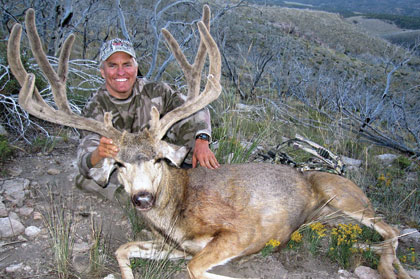February 16, 2011
The majority of my hunting occurs in the wide-open, windswept West where long shots are the norm.
By Randy Ulmer
 The majority of Western hunting occurs in wide-open, windswept country where long shots are the norm. In 2010, the author bagged this Nevada buck in a heavy crosswind. |
The majority of my hunting occurs in the wide-open, windswept West where long shots are the norm. These are the places where I face tough shots across open terrain in the midst of whistling crosswinds nearly every year. In fact, the Nevada buck I was fortunate enough to take just a few days ago would not have made it to my trophy room had I not prepared for these challenging shots. In this month's column, I'll walk you through the equipment selection and preparation needed to execute accurate shots in the wind.
Gearing Up
If you know you will be facing crosswinds often during the season, select equipment that reduces arrow drift and makes it easier to hold the bow steady. Here is what I do.
Advertisement
The Arrow: You can dramatically reduce the distance your arrows drift simply by selecting the right shaft, broadhead and fletching combination. Drift is proportional to the side load applied to the arrow, fletching and broadhead by the wind. The smaller these components are, the less surface area the wind has to push against. As a result, the side load goes down and the arrow drifts less.
The amount of time the arrow is in the air also affects how far it will drift. The wind operates against the shaft at the same force whether the arrow is in the air for two seconds or half a second. The longer the wind can push on the arrow, the farther the arrow will drift.
Advertisement
If reduced wind drift is your goal, try to achieve a total arrow weight that is roughly six grains per pound of draw weight (I shoot a 438-grain arrow at 70 pounds draw weight). The IBO standard is five grains per pound, and most of today's bows will handle arrows this light without undue stress. However, if you get too light, stability and downrange speed retention are affected. A finished arrow around six grains per pound is a good choice. In other words, for a 60-pound bow, your total arrow weight (with broadhead installed) should be 360 grains or more.
I used to shoot typical fixed-blade broadheads, aluminum arrows and 4-inch fletching. Now, I shoot compact heads (Rage 100-grain), small diameter shafts (Easton A/C/C) and short fletchings (AAE 2.3 inches). Based on data I have gathered from many hours of testing in windy conditions, my arrows now drift only one-third as far as they did under comparable conditions with the larger arrows. By changing all my arrow components, I have reduced wind drift by 66 percent!
Bow: A heavy body has more inertia than a lighter one, so it takes more force to cause it to accelerate. The more your bow weighs, the harder it will be for the wind to jostle it around like a rag doll. It will hold its position better against gusts, allowing steadier aiming. You can add weight to a bow in several ways, but a stabilizer is one of the easiest. You can also purchase weight packages that mount to the lower portion of the riser from manufacturers specializing in gear for target archers.
Reducing the wind drag of the bow is the next step in making it aim better. Again, it comes down to surface area. By removing your quiver when you shoot (or just removing the arrows themselves from non-detachable quivers), you will reduce the distance your arm moves when buffeted by the wind.
Shooting Technique
There isn't much you can do at full draw to make the wind lay down, but you can be patient and wait for the occasional lull. There is often a rhythm to the wind, and if you watch the grass or leaves blow, you can see it and hear it. In fact, if you watch closely enough, you can even see the lull before it reaches you in the same way wind surfers look for gusts on a lake. Normally, there is a lull right after a hard gust. If the animal isn't going anywhere, be patient until you gain a feel for the rhythm of the wind and find a way to get the pin to stop moving violently.
Practice
Find an open area where you can practice with a crosswind, a headwind, a tailwind and every direction in between. Pay attention to the angle of the wind; the more you are shooting into or with the wind, the less your arrow will drift. Learn by experimentation how far the arrow drifts in every situation. Write it down in a notepad. To gain a quantifiable measure of wind speed, drop grass clippings from shoulder height to see how far they blow.
My final word is one of caution. You will tend to rush the shot when your pin finally settles. Don't undo a summer of practice by getting into the bad habit of punching the trigger now. Focus on making a faster squeeze (but a squeeze nonetheless) and you can shoot both quickly and accurately.
You simply can't attempt some shots. If the pin never settles as you aim, you have no choice but to let down and try again later. Patience and restraint are the keys to performing well and ethically when the wind is blowing.

